Choosing the correct snowboard setup is vital for having a good time on the hill. This involves selecting correctly fitting boots, bindings and the right size snowboard.
When choosing a snowboard there are lots of factors to consider such as flex, camber profile, shape, sidecut and size. The size of a snowboard relates to both length and width.
As a beginner, arguably the most important aspect is choosing the correct snowboard size, as this will make learning to snowboard a much more pleasant and enjoyable experience.
In this guide I discuss how to choose snowboard size by determining the correct length and width snowboard for you.
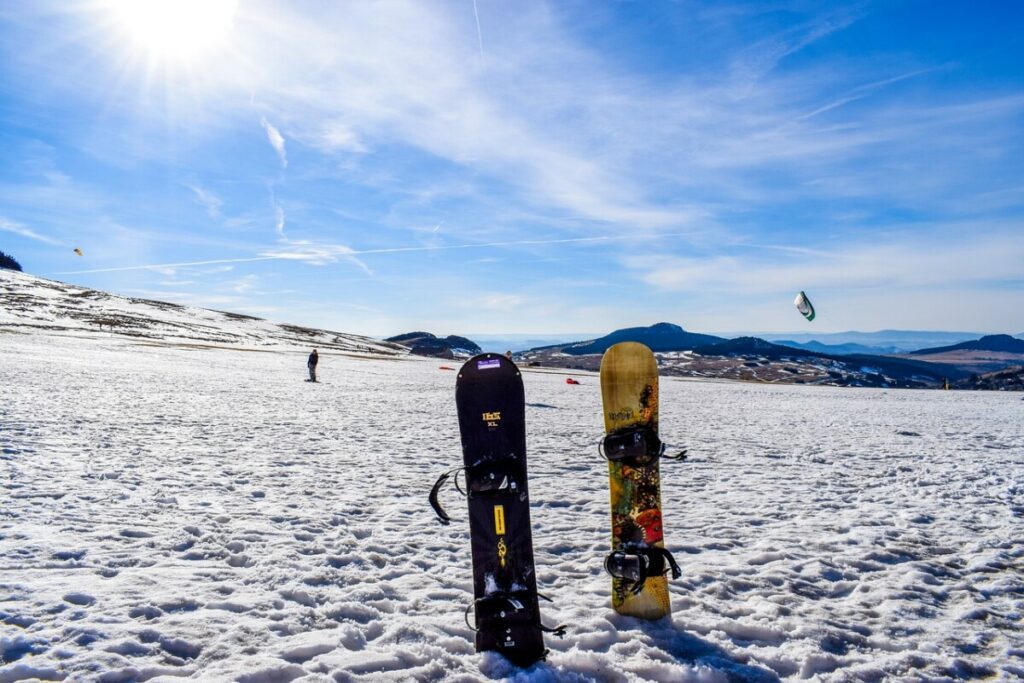
Disclaimer: Some links in this article are affiliate links, which means that if you purchase through them I receive a small commission, at no extra cost to you. This helps cover the cost of running this blog. Thanks for your support!
How to Choose Snowboard Size
When it comes to choosing snowboard size, there are two dimensions to consider. These are snowboard length and snowboard width.
The length of the snowboard is how long the board measures from nose to tail and board length is measured in centimetres.
The width of the snowboard is the distance from the heel edge to the toe edge at the narrowest point along the board, known as the waist. Snowboard width is measured in millimetres.
SNOWBOARD LENGTH
How Long Should a Snowboard Be?
Traditionally snowboard length was dictated by rider height, with snowboard length typically sitting between the collarbone and chin of the rider when the snowboard is stood up on its end.
However, as technology has developed so has the way we determine snowboard length, so height isn’t the best measurement to use by itself. In fact there are several factors to consider when choosing the length of your snowboard. These factors are:
- Weight
- Ability
- Riding style
- Height
Let’s discuss these factors in a little more detail.
Weight
Arguably the most important factor to consider when picking the right length snowboard is rider weight. This makes sense since weight can differ hugely between people of the same height and that’s why height alone can be misleading.
Weight is such an important factor in choosing the best snowboard length because it has a direct impact how the board performs. Boards are designed to perform in a certain way to suit particular riding styles, for example terrain park riders or powder hounds. The main way this is achieved is through snowboard flex and flex rating is linked to snowboard length.
I won’t dive into snowboard flex too much here but just be aware that for a board to perform as it should, it needs to flex appropriately and this happens through driving your weight through the board.
So, if you’re a light person and pick a board designed for a heavy person, you’ll struggle to get it to manoeuvre like it should as the board will be too long. Conversely, a heavy rider rider who uses a board below the suggested weight range (ie the board is too short) will find the board flexes too much and the board will wash out.
Nearly all snowboard brands provide weight range recommendations for their boards these days and these are usually printed in a table and attached to the board. This is a range rather than an absolute, so it’s a good starting point in consideration with other other factors.

Ability Level
As a beginner, getting the right snowboard length will make a huge difference. Boards that are too long are difficult to turn, which is not what you need when you’re learning. For this reason, it’s better for beginners to choose snowboards on the shorter end of the recommended range.
Advanced riders have the ability to use a wide range of snowboard lengths, styles, profiles etc so a more important factor for seasoned snowboarders is the style of riding they prefer and what type of terrain they spend most of their time on.
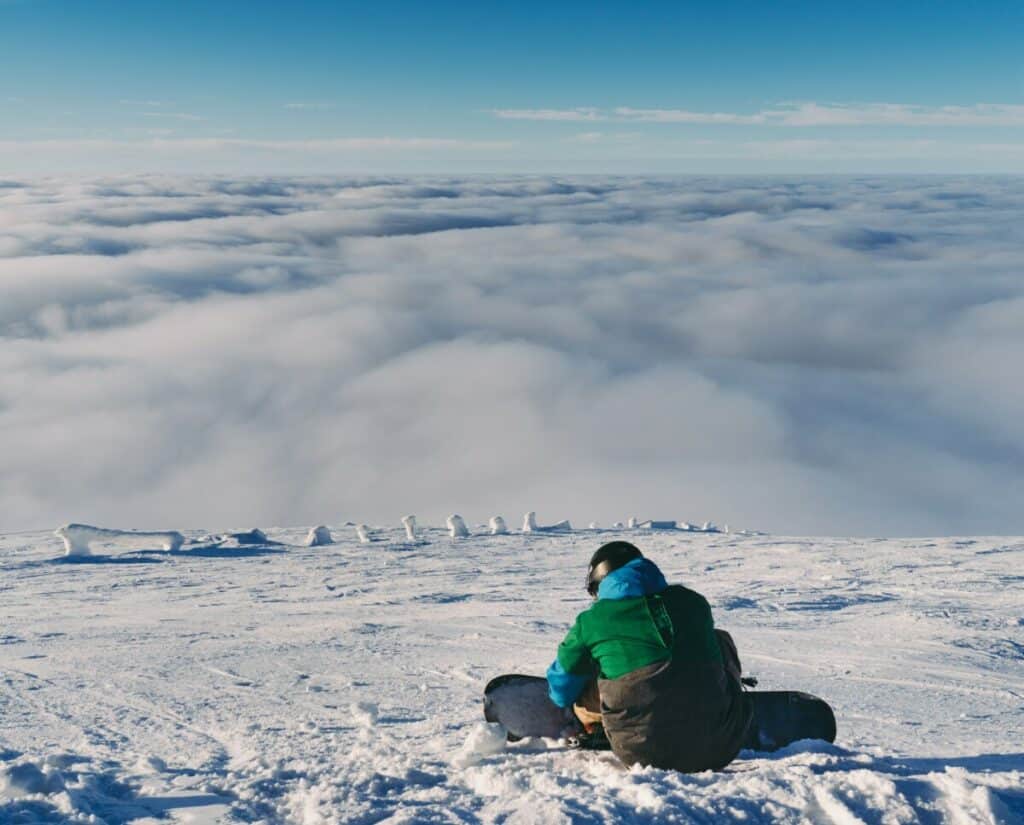
Riding Style/Rider Type
Snowboards are sold with a particular type of riding in mind. The flex, profile (camber or rocker) and shape of the snowboard will all be designed with this in mind.
All-mountain
All-mountain snowboards are designed to work well in all conditions from park to powder. For this reason, where a range of sizes is given for your particular weight (and height), the recommendation is to select a board length in the middle of the range.
That being said, as an all-mountain rider, if you spend more time doing freestyle opt for something slightly shorter in the range or if you spend more time free-riding opt for something slightly longer in the range.
Freestyle
Freestyle snowboards are quite flexible and are designed to work well in the terrain park on jumps, jibs and rails. Predominantly freestyle riders should choose boards shorter in length, within the guidance of those offered in the weight range.
Free-ride
Finally, freeride and powder snowboards are designed for enjoying steep and deep terrain and therefore a longer board is recommended. Longer boards typically produce more stability at speed and help the snowboard to float better in powder.
The exception to this is with volume shifted snowboards, which trade in length for width to maintain the same surface area. These short and wide snowboards provide a surfy-like float in powder and are quick to manoeuvre through tightly packed trees. Volume shifted snowboards are typically 3-6cm shorter than your ideal length board.
Learn more about snowboard shapes here.
Split-boards
As splitboards are designed specifically for use in powdery backcountry conditions, the recommended length for these is the very upper end of the range, plus 1 or 2 cm more. To learn more about splitboarding, see this guide.
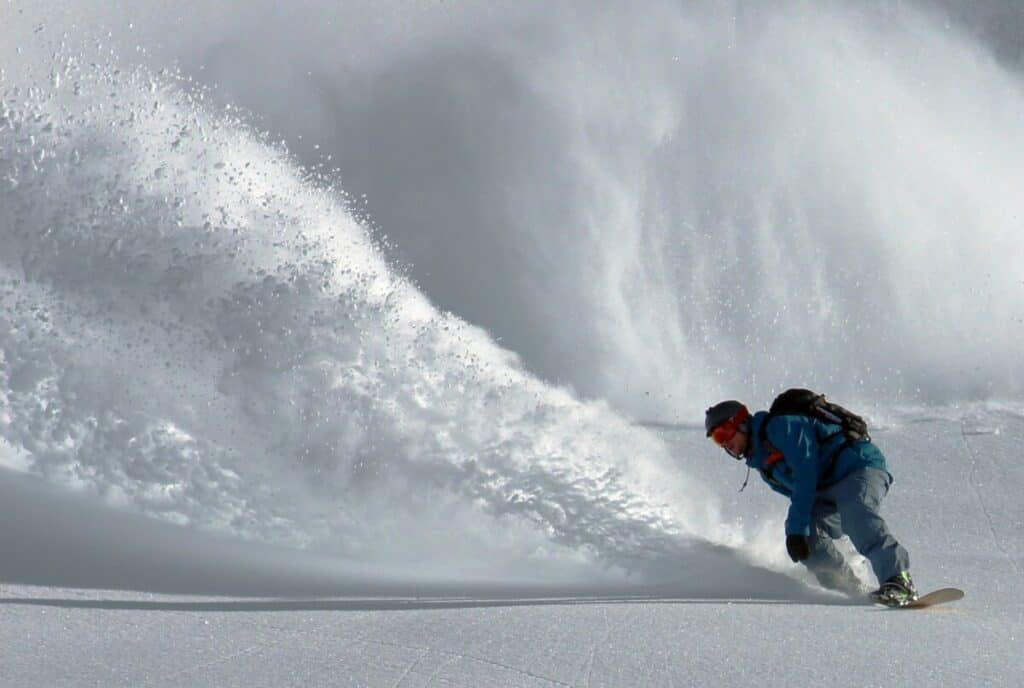
Height
As mentioned at the start, height might be a handy, quick guide for beginners and if you rent a board this might be the criteria rental shops prefer to use.
Consideration to height should be given if, for example, you are very tall but very light. A taller frame often results in a wider stance so despite being light, a longer board might be quite manageable or perhaps a longer board is needed to provide the preferred stance width.
Conversely, this is also true if for example you are heavy set but short – a longer board might be correct for your weight but it may feel too cumbersome with a narrow stance and may force you into having a wider stance than is suitable.
In these instances, it is particularly important to take into account all other factors and it might ultimately come down to personal preference.
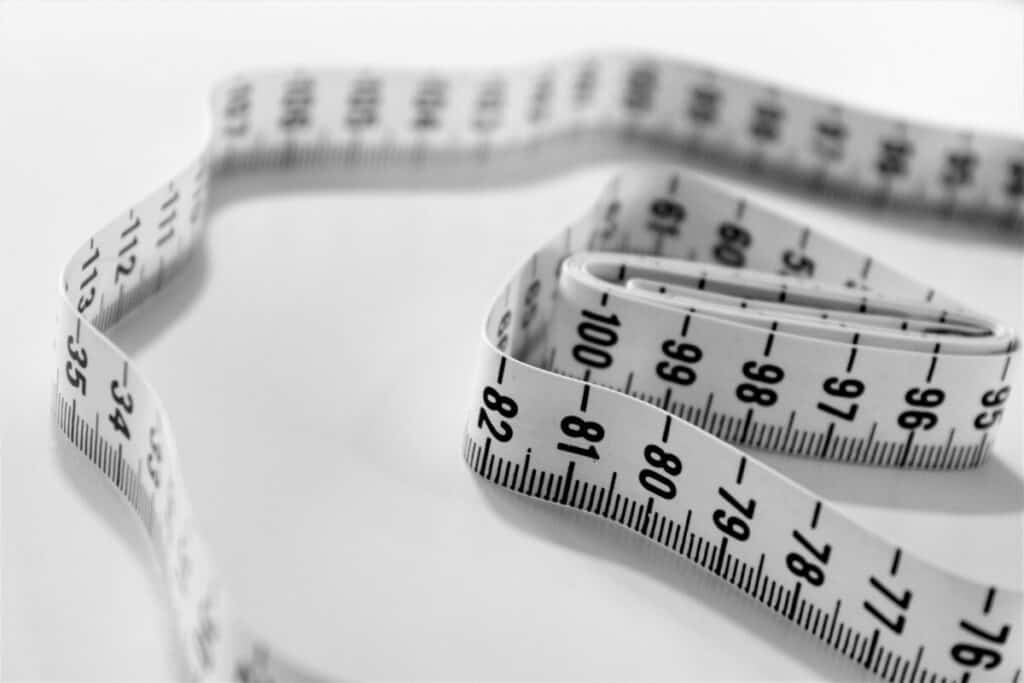
Snowboard Size Chart
Although height isn’t the best guide to use to dictate snowboard length, it makes more sense when paired with rider weight. So use the chart below to find the correct snowboard length for your height and weight, then determine your rider ability and type to decide whether to opt for the shorter end or the longer end of the range.
Have this number in mind but be flexible to allow for more buying options. Since there is no standardised flex rating across the brands, every snowboard will vary slightly, so don’t be doggedly attached to a particular board length.
A the end of the day, one or two centimetres in either direction of the ideal won’t have a major impact on snowboard performance.
Click on the links to convert your weight and height to imperial, if you’d prefer.
Men’s Snowboard Size Chart
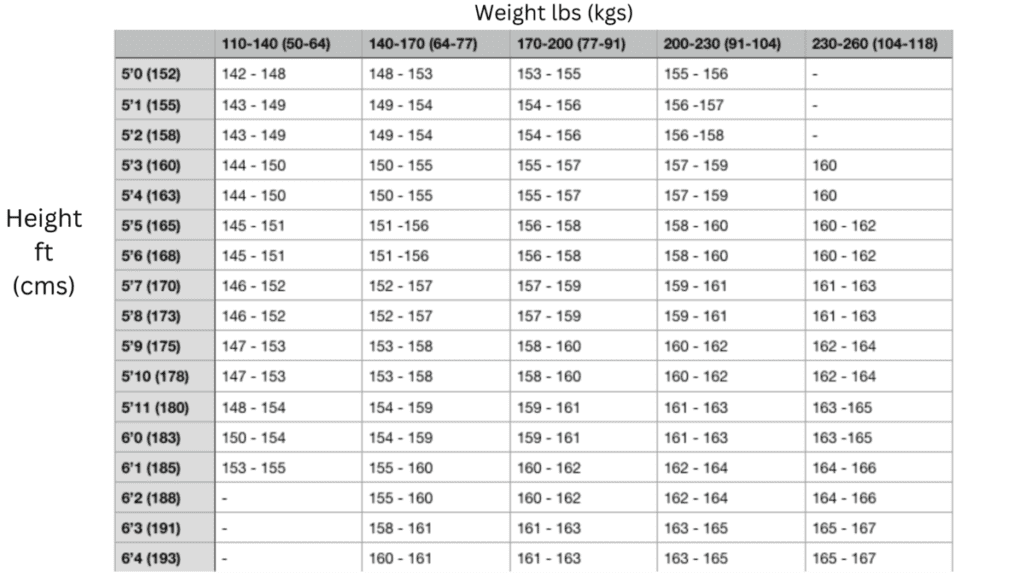
Women’s Snowboard Size Chart
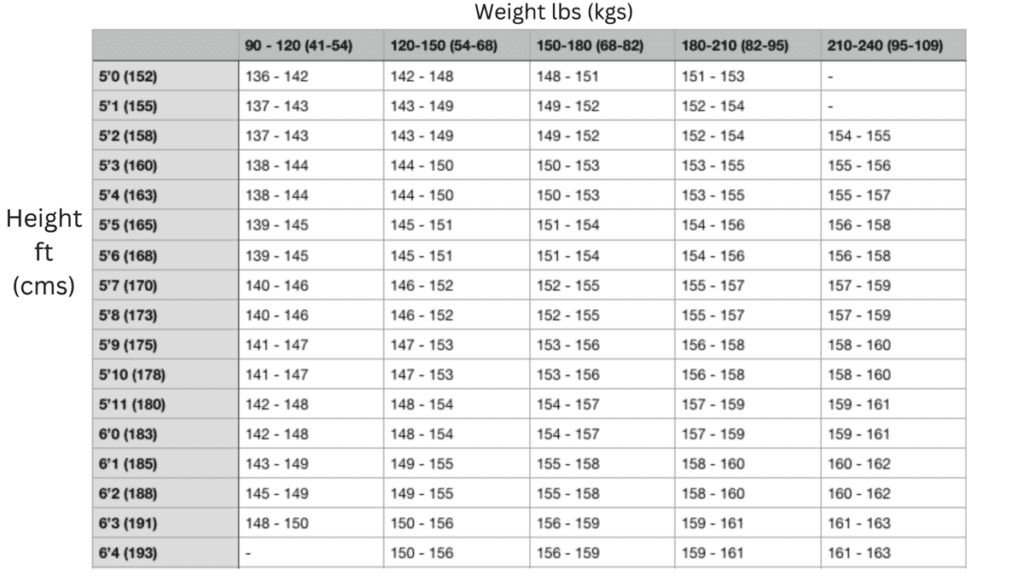
SNOWBOARD WIDTH
Determining the Correct Snowboard Width
Choosing the correct snowboard width will be determined by your boot size. As a general guide, your snowboard boot should hang slightly over each edge of the snowboard. This optimal alignment allows for the best edge control over your snowboard.
If the board is too narrow, your boots will hang over the edges too much causing heel or toe drag. This drag will negatively affect your riding, throwing you off-balance and making carving impossible.
Conversely if the board is too wide for your boot you will struggle to exert control over the board or get up on to the edges.
Snowboards are available in narrow, regular, mid-wide and wide, with regular being the most readily available. If you are only marginally over the ideal limit don’t be in a rush to choose a wide board, as a regular size will be more manageable.
It’s important to note that the need for a wide board can be negated through playing with binding angles or through finding a boot with a smaller footprint. To discover what bindings angles you need, take a look at this guide.
Alternatively, if you have large feet and mostly ride powder, then opt for a volume shifted snowboard which is a short and wide shaped board.
Snowboard Width Size Charts
Use the charts below to determine the right snowboard width for you.
Men’s Snowboard Width Chart
| Board Type | Waist Width | US Boot Size | EUR Boot Size | UK Boot Size |
| Narrow | 240-245 | 6-8 | 38-40.7 | 5-7 |
| Regular | 245-250 | 8-9.5 | 40.7-42.7 | 7-8.5 |
| Regular | 250-255 | 9.5-10.5 | 42.7-44 | 8.5-9.5 |
| Mid-wide | 255-265 | 10.5-12 | 44-46 | 9.5-11 |
| Wide | 265-268 | >12 | >46 | >11 |
Women’s Snowboard Width Chart
| Board Type | Waist Width (mm) | US Boot Size | EUR Boot Size | UK Boot Size |
| Narrow | <235 | <6 | <36.7 | <4 |
| Regular | 235-240 | 6-7.5 | 36.7-38.7 | 4-5.5 |
| Regular | 240-245 | 7.5-8.5 | 38.7-40 | 5.5-6.5 |
| Wide | 245-248 | >8.5 | >40 | >6.5 |
The choice of wide snowboards for women is fairly limited but more are slowly coming onto the market. For example, the Capita Birds of a Feather is available as wide on their 148cm, 150cm and 154cm boards, which are much shorter options than any available in the mens range.
However, for the most part, women with larger feet typically have to opt for mens snowboards unless they can find a boot with a smaller footprint or adjust their binding angles accordingly.
Read Next
Snowboard Size Guide Summary
Snowboard size is determined by length and width. The correct snowboard width will be determined by snowboard boot size.
Choosing the correct snowboard length involves several factors including weight, height, ability and riding style. Use the charts and advise above to find your ideal snowboard length but be flexible in your decision.
Before committing to buy, you can try different lengths through renting equipment or at test days often held at resorts.
